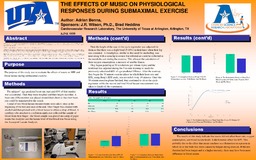| dc.contributor.author | Benna, Adrian | |
| dc.date.accessioned | 2017-07-05T18:44:34Z | |
| dc.date.available | 2017-07-05T18:44:34Z | |
| dc.date.issued | 2016 | |
| dc.identifier.uri | http://hdl.handle.net/10106/26858 | |
| dc.description | KINE 4400 | en_US |
| dc.description.abstract | INTRODUCTION: Studies have shown that music can have psychological effects on a person. It can affect a person’s emotions and stress levels. Other variables that can be affected by music are heart rate and rate of perceived exertion (RPE). RPE is used as a way to measure workout intensity subjectively and is usually presented in the form of Borg’s scale. Heart rate is also a good indicator of the intensity of the workout. During exercise, there is an increase in sympathetic activity because of the body’s demand for more oxygen which also increases HR.
PURPOSE: The purpose of this study was to evaluate the effects of music on RPE and blood lactate during submaximal exercise.
METHODS: Five students, four from the Kinesiology Department and one from outside of school, volunteered to participate in this study. Each subject was required to come to the lab for one hour on two separate days. Height, weight, age, and 60% of heart rate max were recorded first. Then the first blood lactate was recorded. The subject then began the 30 minute ride at 60% of their heart rate max on the cycle ergometer while RPE, heart rate, and oxygen consumption were recorded every ten minutes. At the end of the ride a second and final blood lactate was recorded. The next day the subject came he or she brought their music playing device to use during the 30 minute ride. Days with music and without music were chosen randomly.
RESULTS: The mean RPE for music was 8.8 ±2.2 and without music was 11.1 ±2.7 which was significantly different (p=0.02). The mean heart rate for music was 119.4 ±3.4 bpm and without music was 120.7 ±3.7 bpm did not result in a significant difference (p >0.05). The mean VO2for music was 18.28 ±4.1 ml/kg/min and without music was 17.62 ±3.3 ml/kg/min were not significantly different (p >0.05). The pre-blood lactate for music was 2.78 ±1.4 mmol/L and without music was 2.88 ±1.7 mmol/L. The post-blood lactate for music was 3.96 ±1.3 mmol/L and without music was 3.0 ±1.3 mmol/L were not significantly different (p >0.05). There was no significant difference between pre and post blood lactate with music(p>0.05) and without music (p>0.05).
CONCLUSION: The results of this study indicate that music did not affect heart rate, oxygen consumption, and blood lactate levels. It did however affect the RPE. This probably due to the effect that music can have as a distraction on a person in which he or she feels less stress caused by fatigue during exercise. | en_US |
| dc.description.sponsorship | Wilson, J.R. and Heddins, Brad | en_US |
| dc.language.iso | en_US | en_US |
| dc.subject | Physical activity | en_US |
| dc.subject | Submaximal exercise | en_US |
| dc.subject | Music | en_US |
| dc.subject | Heart rate | en_US |
| dc.subject | Evaluation | en_US |
| dc.title | THE EFFECTS OF MUSIC ON PHYSIOLOGICAL RESPONSES DURING SUBMAXIMAL EXERCISE | en_US |
| dc.type | Presentation | en_US |
| dc.publisher.department | Department of Kinesiology, The University of Texas at Arlington | en_US |
| dc.publisher.department | Cardiovascular Research Laboratory, The University of Texas at Arlington | en_US |
| dc.publisher.department | Exercise Science Research Laboratories, The University of Texas at Arlington | en_US |

